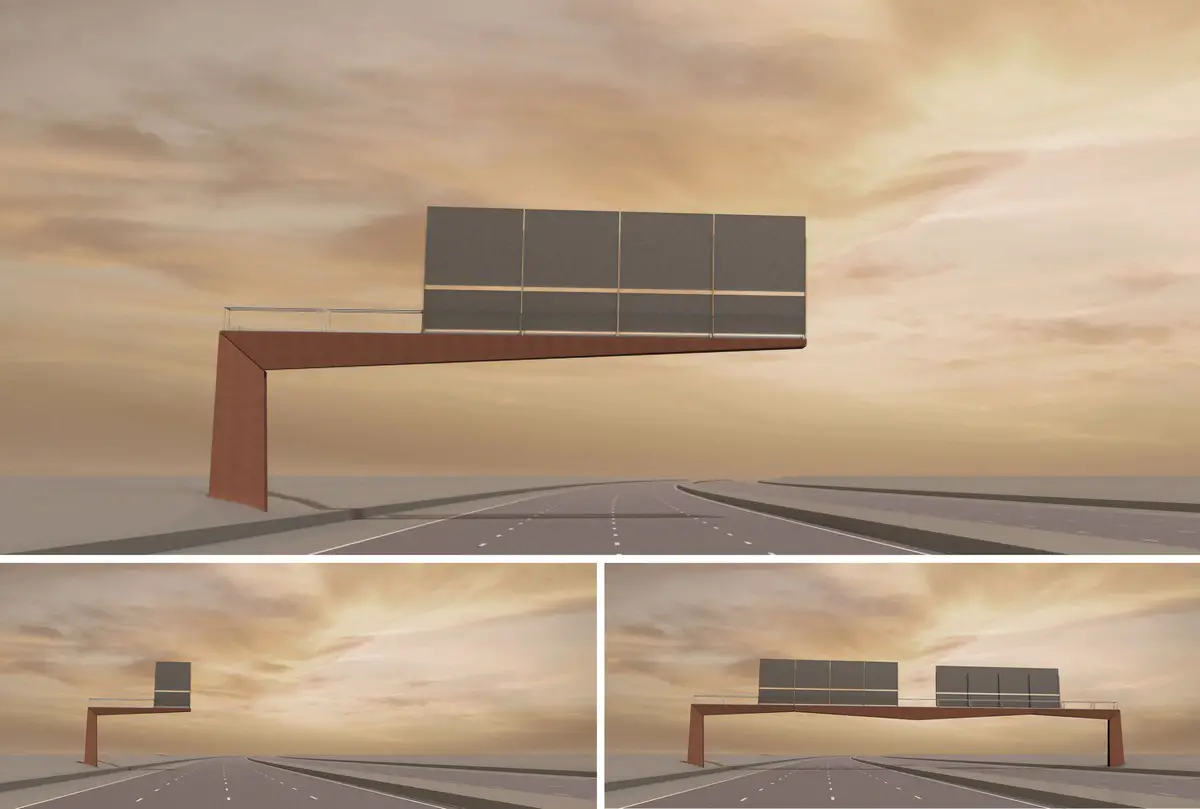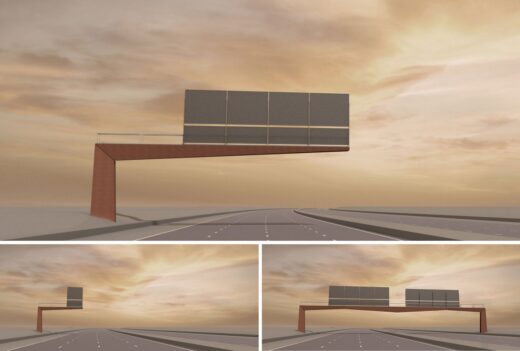Evolution of gantries RIBA Competition winner, UK Architecture Contest, British Building Architects News
Evolution of gantries RIBA Competition News
10 March 2023
Sleek, innovative and reduced carbon design tops National Highways gantry competition
Location: United Kingdom
Evolution of gantries RIBA Competition Winner News
10th of March 2023 – National Highways is today proud to unveil this winning design as part of an exciting competition to create the ‘gantry of the future’ for its motorways and major A-roads.
Millions of drivers see gantries every day as a routine part of their journeys – and probably don’t give them much thought. However, they are vital to providing safe and reliable journeys and giving drivers information they need to reach their destinations.
The competition was organised by National Highways in conjunction with the Royal Institute of British Architects (RIBA), with 32 entries from architectural firms from across the UK and Europe.
The winning entry, created by Useful Studio, features a simple, pared-back design approach. It was chosen by the judging panel for its elegance and simplicity, and how cohesive the design concept was across a range of different structures. As well as a modern look, it will also have less impact on the environment, with a projected reduced carbon footprint compared to current gantries. Useful Studio will now work with National Highways to develop their design concept, with a view to it becoming the standard design for new roads and major upgrades from around two years’ time.
National Highways has been seeking a more streamlined, elegant and consistent visual appearance for roadside gantries to enhance the public’s driving experience. Existing designs tend to be heavily engineered, with an emphasis on function over form.
These changes go hand-in-hand with creating a more efficient standardised structure that also has a reduced carbon footprint, both in terms of the carbon needed for construction and also lower operational and maintenance costs.
The winning entry uses less steel than existing designs, meaning less embodied carbon, and the use of pre-weathered rather than painted steel. The design follows existing best practice from other highways structures and ages better than painted steel, meaning potentially lower maintenance requirements and fewer lane closures and delays for drivers.
It can be adapted for different types of structures including those spanning all carriageways and the roadside signs. We currently have 3,500 gantries, but won’t be immediately replacing structures.
National Highways Executive Director for Operations Duncan Smith said:
“This is a great opportunity for us to develop a more streamlined, elegant, and consistent visual appearance for roadside gantries to enhance drivers’ experience when driving on England’s motorways and Major A-roads.
“Existing designs tend to emphasise function over form, our challenge is to create innovative structures that can accommodate the required signage and equipment that are more sympathetic to the environment.
“In selecting Useful Studio as the winner, the judging panel admired the simplicity and elegance of the pared-back design approach, and the opportunities it presented in terms of a resource efficient, standardised, coherent suite of gantry structures that would be potentially sympathetic to a broad range of settings and contexts.”
Jonathan McDowell, RIBA Architect Adviser said:
“It is very encouraging that National Highways is actively engaging the design community in helping to improve the design of these ubiquitous but cumbersome parts of the motorway experience – we enjoyed seeing a wide range of interesting ideas, including those which challenged National Highways’ current practices. The simple and elegant approach of the winning proposal has the potential to greatly improve the appearance and resource-use of these structures, and we look forward to seeing how it is developed and implemented.”
Roads Minister Richard Holden said:
“Congratulations to Useful Studios and National Highways for their success in creating a modern, secure design that is set to redefine the look and feel of our motorways and roads.
“Their innovative approach is bound to improve the daily journeys of countless motorists while also contributing to a more sustainable future.”
Although security issues did not form part of the original specification, the new design will be more resilient to trespassers due to entry being concealed within the pillars, making it more difficult to access without authorisation.
Other entries also demonstrated a range of fresh thinking and innovation in approach to the design, including wood composite and LED panel-based designs, as well as identifying the challenge of removing gantries completely in favour of in-vehicle displays.
A design by John McAslan+Partners won second place in the competition and three other concepts were highly commended by the judging panel, which was made up of experts in the architectural and highways fields.
The competition is part of National Highways good design initiative, which sets out 10 principles for good road design including that they should:
• fit into context: good road design demonstrates sensitivity to the landscape, heritage and local community
• be understandable: good road design focusses on the essentials and eliminates unnecessary and confusing clutter
• be environmentally sustainable: multi-functional, resilient and sustainable, good roads achieve net environmental gain.
It has been funded by National Highways’ designated fund, innovation and modernisation theme. Useful Studio will go on to work with National Highways structures team to adapt the design to meet road safety and design standards. The new structures could be part of new road upgrades delivered in 2 to 3 years’ time.
In 2018, we set out an ambition for our road upgrades to better complement the natural and built environment in which they lie, and this competition is being run as part of our commitment to delivering that ambition. As well as a better design, having a standardised design will help create a more consistent look and feel across the network for drivers and also make projects more efficient to deliver and help with maintenance regimes.
Previously on e-architect:
2 Dec 2022
Evolution of gantries – the hunt is on to find a new design for vital motorway structures
Location: England, UK
Evolution of gantries RIBA Competition News – English Contest
2nd of December 2022 – The look of England’s motorways has evolved in recent decades and now the search is on to redesign one of the network’s most iconic features – the gantry.
As part of its good design initiative, National Highways is seeking concepts for a new generation of highway gantries through a competition to be run by the Royal Institute of British Architects (RIBA).
As motorways have developed over the decades, new types of gantry designs have been introduced in response to changes in technology, traffic levels and policy considerations. They have evolved from the humble beginnings of basic signs at the side of the road to the newest gantries spanning the carriageway, allowing both fixed text signs and dynamic information to keep drivers informed of real-time traffic information.
Millions of drivers see gantries every day as a routine part of their journeys – and probably don’t give them much thought. However, they are vital to providing safe and reliable journeys and giving drivers the information they need to reach their destinations.
The hunt is on to find a new design for England’s motorway and major A-road gantries:

photo courtesy of National Highways / RIBA
Mike Wilson, National Highways’ Chief Highways Engineer said:
“This is a good opportunity for us to start to look for creative solutions aligned with our commitment to good road design. I am excited to see this competition launch.
“The competition opens up the opportunity to develop a more streamlined, elegant, and consistent visual appearance for roadside gantries to enhance drivers’ experience when driving on England’s motorways and Major A-roads.”
Jonathan McDowell, RIBA Architect Adviser said:
“It is very encouraging that National Highways are actively engaging the design community in helping to improve the design of these ubiquitous but cumbersome parts of the motorway experience – we look forward to seeing a wide range of creative and elegant proposals that take up the challenge.”
The competition being run by RIBA launches today and runs for eight weeks. It is open to all architects and architect led teams. It is being funded by National Highways’ designated fund for innovation & modernisation. Those capable and experienced in designing such structures and working alongside structural engineers are encouraged to apply.
The competition will not alter the technology that sits behind the physical gantries and any new designs will ultimately still have road safety at their core.
It forms part of an ongoing strategy by National Highways to constantly improve and refine the design of England’s busiest roads, which are used by around 4 million vehicles each day. The company’s good design initiative sets out 10 principles for the network, including that designs should be sensitive to the landscape, heritage and local community; focus on the essentials while eliminating confusing clutter; and be environmentally sustainable, multi-functional and resilient. The company’s fifth annual report on the progress of the good design initiative was published last week
The winner, expected to be announced early next year, will work with National Highways to develop their design concept, with a view to it becoming the standard design for new roads and major upgrades from around 2 years’ time.
The submission deadline is 12:00 midday (GMT) on Tuesday 24 January 2023. The full competition brief can be found on the competition webpage at:
https://www.ribacompetitions.com/gantries/
Background
National Highways
National Highways is the wholly government-owned company responsible for modernising, maintaining and operating England’s motorways and major A roads.
Real-time traffic information for England’s motorways and major A roads is available via its website (www.trafficengland.com), local and national radio travel bulletins, electronic road signs and mobile apps.
The Royal Institute of British Architects (RIBA) is a global professional membership body that serves its members and society in order to deliver better buildings and places, stronger communities and a sustainable environment. www.architecture.com. RIBA Competitions delivers choice, inspiration and value to clients through expertly run competitive selection processes. The dedicated RIBA Competitions team can help you explore the full potential of your project, for further information visit www.architecture.com/competitions or email RIBA.Competitions@riba.org
Location: England, UK
RIBA Design Competitions
RIBA Architecture Competitions – architectural selection below:
The Heath Runcorn: RIBA Vision of Future Living competition winner

image courtesy of RIBA
RIBA Design Competition Future Living Vision
RIBA Heath Park Design Competition, Runcorn
Design: Paul Treacy Architects / Kimia Benam Architects

image courtesy of RIBA
RIBA Heath Park Design Competition
Architecture in England
Contemporary Architecture in England – architectural selection below:
New English Architectural Designs : current, chronological list
English Architect Practices
Comments / photos for the Evolution of gantries RIBA Competition page welcome






